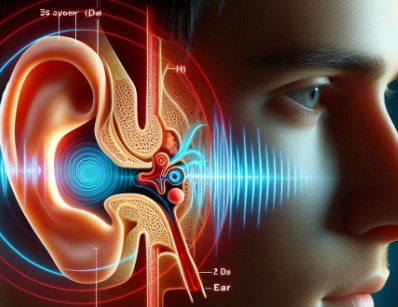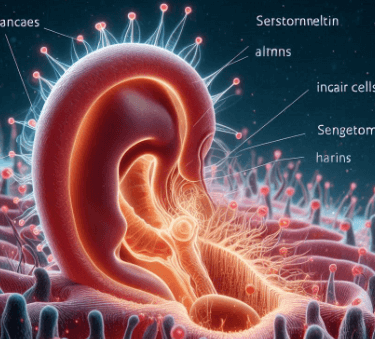Hearing loss happens when you can’t hear as well as you should. It’s more common than you might think. Understanding it better can help you notice the signs early and get the right help. And today it’s all about understanding the different types of hearing loss.
You might notice that you often ask people to repeat themselves or that you need to turn up the volume on the TV a lot. These can be signs of hearing loss. It might start slowly, so you don’t notice it at first, but it can seriously affect your daily life if ignored.
When you can’t hear well, you might miss out on conversations, feel left out, or get frustrated. This can affect your relationships with friends and family. Plus, untreated hearing loss can lead to other problems like depression or anxiety.
Knowing the different signs and types of hearing loss helps you take action. It’s important to not ignore these signs. Treating hearing loss early can make a big difference in quality of life. In the next sections, I’ll break down the different types of hearing loss and what you can do about them.
The Basics: Conductive Hearing Loss
Conductive hearing loss occurs when sound waves can’t pass through the outer or middle ear. Think of it like a blockage that stops sound from reaching the inner ear, where it gets heard and processed.

One common cause is ear infections, which can create fluid build-up. Another cause could be a buildup of earwax or even a foreign object stuck in the ear canal. Sometimes, a condition called otosclerosis causes abnormal bone growth in the middle ear, hampering sound transmission.
Fortunately, conductive hearing loss is often treatable. A doctor might prescribe antibiotics if it’s due to an infection or suggest a procedure to remove excess earwax or objects. In some cases, surgery might be needed to help improve hearing.
Using hearing aids can also be an effective treatment. These devices help amplify sound, essentially turning up the volume of the world around you. With proper treatment, many people with conductive hearing loss can regain much of their hearing ability.
Understanding Sensorineural Hearing Loss
Sensorineural hearing loss is when there’s damage to the inner ear or the nerve pathways from the inner ear to the brain. The inner ear contains tiny hair cells that help transmit sound signals to your brain. When these cells or the nerve pathways are damaged, hearing becomes difficult.

This type of hearing loss can be caused by loud noise exposure, aging, certain medications, or illnesses. Noise-induced hearing loss is a big factor, especially with frequent headphone use at high volumes. Age-related hearing loss, also known as presbycusis, happens gradually as you get older.
One main difference between sensorineural and conductive hearing loss is that sensorineural typically can’t be corrected by medical or surgical intervention. However, there are plenty of ways to manage it.
Hearing aids are a common solution, making sounds louder and clearer. Cochlear implants are another option for more severe cases; these devices bypass damaged parts of the ear and directly stimulate the hearing nerve.
Regular hearing tests and early detection are crucial for managing sensorineural hearing loss effectively. If you experience issues, get checked by a hearing specialist who can offer personalized advice and treatment options.
Mixed Hearing Loss Explained
Mixed hearing loss is exactly what it sounds like—a combination of both conductive and sensorineural hearing loss. This means there’s a problem in the outer or middle ear and the inner ear or auditory nerve.
You might experience mixed hearing loss if, for example, you have age-related hearing loss (sensorineural) and then develop an ear infection (conductive). This combination can complicate things because both issues need to be addressed to improve hearing.
Treatment for mixed hearing loss often involves a mix of methods. You might need medication or surgery to fix the conductive part and hearing aids or cochlear implants for the sensorineural part. It’s all about customizing the treatment to what’s causing your hearing issues.
Dealing with mixed hearing loss can be tricky, but working closely with a hearing specialist ensures you get the best possible outcome.
They can create a treatment plan tailored to your specific needs. Regular check-ups and adjustments to your treatment can also help manage both aspects of the hearing loss effectively.
Understanding that mixed hearing loss requires a multi-faceted approach helps set realistic expectations for treatment and management. The key is to stay proactive and seek out the right combination of treatments.
Living with and Preventing Hearing Loss
Living with hearing loss can be challenging, but there are many tools and strategies to help manage it effectively.

Modern technology has made huge strides in assisting people with hearing loss. Hearing aids have become more advanced, smaller, and more comfortable. Some even connect to your smartphone, allowing you to adjust settings easily.
It’s also helpful to educate those close to you about your hearing loss. Ask them to speak clearly and face you when talking. This simple change can make conversations much easier.
If you struggle in noisy environments, devices like personal amplifiers can be a game-changer. They help amplify speech while reducing background noise. Assistive listening devices in public places like theaters can also enhance your experience.
Looking after your mental health is equally important. Join support groups or online communities to share experiences and get advice. Professional counseling can provide coping strategies and emotional support.
Preventing hearing loss is just as critical. Protecting your ears from excessive noise is key. Wear earplugs at loud concerts or in noisy work environments. Keeping the volume down on your headphones can also make a big difference.
Regular hearing check-ups can catch early signs of hearing loss. Early detection allows for quicker intervention, potentially preserving your hearing longer.
Do you think that you are suffering from hearing loss?
Feel free to leave your comment below, and I look forward to hearing from you.
Kind Regards and Take Care
Roopesh

I had no idea there were so many variations and causes behind hearing loss. The section about distinguishing between conductive and sensorineural hearing loss was particularly eye-opening. I’m curious, though—what are some of the latest advancements or treatments for these types of hearing loss that people should be aware of? It’d be awesome to get an update on the most effective ways to manage or improve hearing health.
Thanks for your thoughtful comment! I’m glad you found the article helpful.”
As for advancements in hearing loss treatments, there have been some exciting developments. For conductive hearing loss, treatments like bone conduction hearing aids and surgical options like implants are improving outcomes.
For sensorineural hearing loss, hearing aids are becoming more advanced with better sound clarity, and cochlear implants continue to evolve.
There’s also promising research into regenerative medicine, looking at ways to repair damaged hair cells in the ear. Staying up-to-date with your audiologist can help you explore the best options!